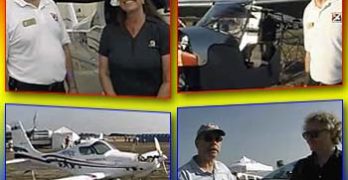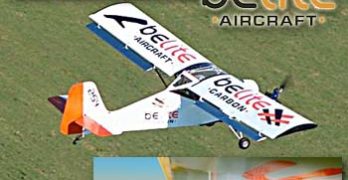One of my joys at AirVenture 2011 was visiting a seemingly revitalized Ultralight Area. Though a shadow of its former self in the 1980 heydays, new life seemed to be springing up, whether through electric powered aircraft or affordable Part 103 fixed wing designs.
Proving the naysayers wrong (again!) were at least two intriguing Part 103 airplanes you can buy and fly today for less than $20,000. That’s well the under the average price of a new automobile for a ready-to-fly aircraft with desirable features, not a stripped-down machine that no one really wants. I wrote about Terry Raber’s lovely little Aerolite 103. A day after looking over his work, UltralightNews and I shot a video review of the Valley Engineering Backyard Flyer. Once again, I had my eyes opened.
If you’ve ever visited AirVenture’s Ultralight Area, odds are you saw a pilot known as the “Flying Farmer” doing circuits of the Ultralight Area pattern.
Best Bargain in a Ready-to-Fly Airplane?
Many pilots speak of airplanes they cannot afford. Indeed, $150,000 Light-Sport Aircraft are priced beyond common budgets. One way to solve this is through a partnership or fractional ownership… and I will be writing about partnerships later this year. *** Another way involves a ready-to-fly aircraft for under $15,000. You read it right: $14,995 for a ready to fly aircraft with many features you want including electric starting, flaps, brakes, tricycle gear, and instruments. I must also mention it successfully meets U.S. Part 103 ultralight regulations. Plus, it is great fun to fly! *** Welcome back to Terry Raber’s brilliant Aerolite 103… literally brilliant in day-glow orange (photo). An amazing value, let me list a few of the standard equipment items: Factory-built; Hirth F-33 engine with electric start & battery; nose fairing & windshield; instruments including airspeed, altimeter, tachometer, EGT, CHT, and clock; electric flaps; steerable nose wheel with suspension; and four-point restraint system (this list does not include everything you get).
Wired Gets Air-Wired
Following up on my post two days ago, I’m happy to report Wired magazine just ran a story online about the Yuneec E-Spyder that Tom Peghiny of Flight Designs has been developing for them. The story has several excellent photos and it’s a good write-up, so click on over there to see how the mainstream media is helping push public awareness of electric aviation. *** Here’s the Wired video of the E-Spyder that ought to whet your appetite for electric flight…I can’t wait to get back to the states and get over to Tom’s to do my own story on it.
Update 10/29/10 — After Jim Lawrence and I did our bits on the E-Spyder and electric airplanes, Wired blogger Jason Paur wrote another piece for Wired Autopia that represents more great reading you should check out. Jason’s newest article summarizes all the electric-powered light aircraft developments quite well.
Whirring into the Air on Electricity
You’re probably aware of the auto industry’s billion-dollar bet on electric cars. Skeptics are plentiful. Same for airplanes. Despite doubts, even Cessna and Bye Energy are teaming up on an electric 172. Other LSA electric projects are also underway and it’s all good in my mind. *** Most e-powered aircraft remain in the future. Yet here today is the E-Spyder. You can place an order that’ll set you back less than $30,000. Plus it’s a true Part 103 ultralight meaning you don’t need no stinkin’ government license to fly it. *** I wish I lived closer to Woodstock Connecticut where co-developer Tom Peghiny is flying Yuneec’s E-Spyder along with a few trusted friends. The one they’re flying has longer wings and a battery-hiding compartment (top photo, circled). Tom wrote, “We have been flying a lot since finishing the plane in mid September.” So far Tom and team have taken 15 flights on the upgraded version. This prototype (#3) has many changes over the original that was shown at Airventure in 2009.
Part 103 Enthusiasm Continues; Welcome E-Spyder!
Part 103 continues to step from the shadow of Light-Sport Aircraft. We’ve had aviation’s simplest rule (worldwide!) for 27 years and with few exceptions, most of those years saw Part 103 producers laboring in near-obscurity. *** Now, however, a new flurry of activity has developed at the beautiful intersection of genuinely lightweight aircraft with electric power. The very latest to roll into the spotlight is Flightstar‘s E-Spyder, which took its first flight today. E-power from Yuneec in China meets an all-American airframe. The accompanying photos show what a clean matchup these components achieve. *** Flightstar mounted the twin lithium polymer battery packs on either side of the design’s robust main fuselage tube. Electric motors are more user-friendly in nearly every way, but you have some new learning to do. For example, experts advise never allowing lithium polymer batters to drain completely. Fortunately, the Yuneec controlling hardware provides warning systems to help you manage this task.
Judging Winners Sun ‘n Fun 2010
I once followed judging at shows like AirVenture and Sun ‘n Fun. In fact, an aircraft I helped inspire — a modernized primary glider called the SuperFloater — won Outstanding New Design at Sun ‘n Fun 1995. Judges closely examined homebuilts, kit or restored vintage airplanes, and warbirds. If they included factory built aircraft, I was not aware of it. *** So, this year I admitted surprise after learning factory-built Light-Sport Aircraft won awards. *** To honor the hundreds or thousands of hours people put into their winners, I want to highlight some LSA and ultralights that judges liked. The Grand Champion LSA was Wayne Spring’s 2010 Predator powered parachute; Reserve Grand Champ was James Jonannes’ 2009 Arion Lightning LS-1; Grand Champion Ultralight was James Wiebe’s 2010 Belite Superlite; and, Reserve Grand Champ was Danny Dezauche’s 2010 CGS Hawk Ultra.
Going Multimedia (Reluctantly at First)
Lots of other aviation news organizations embraced multimedia before ByDanJohnson.com did. We figured online was already quite lively with hyperlinks and true interactivity as represented by our exclusive PlaneFinder 2.0 feature. *** About a year ago, of UltralightNews approached me with an idea to do brief reviews of LSA. I accepted his invitation and today we are well on our way to having a 4-8 minute video mini-review for each of the 105 SLSA on the market. Other professional outlets like AvWeb, ANN, AOPA, and EAA offer multimedia topics all over the aviation map, but ByDanJohnson.com maintains a tight focus on all manner of light aircraft flown by Sport Pilots. *** With that manifesto in mind, we observe for you that we just posted new reviews on our LSA Videos page and we invite you to watch these… for free and without even having to register.
Belite’s Carbon Fiber Part 103 Ultralight Vehicle
If you’ve been around aviation long enough you’ve heard the Q&A: “Know how to make a small fortune in aviation? Start with a large one!” Yet aviation can always use fresh talent, so welcome former tech entrepreneur, James Wiebe, turned aviation businessman. From his days building Mac peripherals under the name Newer Technology (and reaching sales of $60 million), Wiebe sold his tech enterprises and, in January 2009, bravely launched Belite Aircraft. The first flight came July 4th.
Wiebe chose to incorporate stronger, lighter carbon fiber technologies to replace steel, wood, and aluminum. The result is a three-axis, full-cockpit airplane with a full instrument panel that can be built to weigh less than Part 103’s 254-pound maximum. Though employing plenty of costly carbon fiber including on the firewall, Belite uses a welded steel frame for strength and safety. The premium Belite 254 CF includes carbon fiber wing spars and ribs, hydraulic brakes, aluminum wheels, full flight instrumentation, built in transceiver, a bigger 45-hp engine, enhanced electrical system, and a Gizmo GPS dock.
Part 103 Belite Flies; Electric Power Coming
Part 103 ultralights seem eclipsed by the attention awarded to Light-Sport Aircraft. But a Wichita tech entrepreneur who sold his business is now pursuing aviation focused on the airplane formerly known as the Kitfox Lite. *** James Wiebe bought the rights to the single seater, opened shop as Belite Aircraft, and immediately started replacing aluminum and wood components with carbon fiber. The result is a genuinely light aircraft than can make Part 103 with several pounds to spare. *** On July 4th, as America was blowing off fireworks, James fired up his 28-horsepower Zanzottera MZ-34 engine to make his maiden flight. “While the rest of the country was focused on celebrating independence, I was experiencing it, making lazy circles in the sky above Jabara Airport,” Wiebe expressed. As flown, the airplane weighed approximately 245 pounds and that included the optional rear window and a full VFR panel.
Green Power — Earthstar’s All-Electric eGull
The hum of interest in electric-powered aircraft continues, a parallel to development of electric automobiles. Despite their woes all over the news, the auto industry is spending millions on electric power. In sharp contrast, electric airplane developments are being done on tiny budgets by entrepreneurs.
Yet enough development is happening that the German Aero show will have a show-within-a-show, the e-flight-expo. Says German publisher and co-organizer of the event with Aero management, Willi Tacke, “At this moment we have a dozen trend setting exhibitors to participate at the first e-flight-expo April, 2-5, 2009.”
I’ve written about electric projects: Electra Flyer/others and Sonex. The newest entry involves one of my all-time favorite airplanes, the Earthstar Aircraft Gull 2000. This ultra-light single seater flies efficiently on a very small wing, so when I spoke to Mark Beierle recently I got excited when he told me he’s working on the eGull.
- « Previous Page
- 1
- …
- 3
- 4
- 5
- 6
- Next Page »










